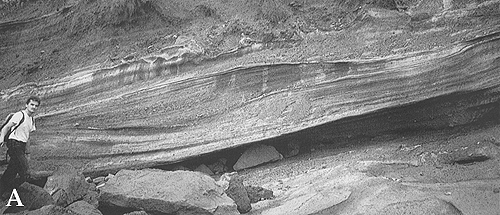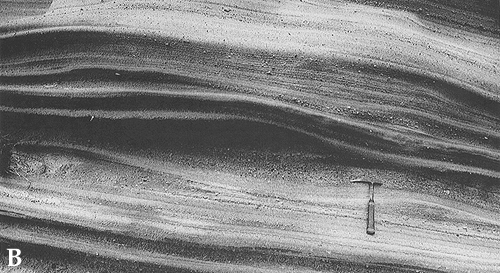

Dunelike bed forms (dunoids)
Plate 38
These are dunelike structures that are typical of pyroclastic deposits and occur either as isolated or serial forms. Contrary to antidunes, they fossilize quite easily, but are never seen on exposed surfaces as fine ash buries them immediately after their formation. This obviously reflects their origin from catastrophic flows that carry a great amount of particles in suspension and rapidly dissipate their energy. Dunoids (a term proposed here) can thus be examined only in section view, where they appear as sets of inclined laminae with a wavy surface on top, draped by an ash bed (see also plate 39, and color photos 4, 15).
Why not call these structures dunes or sediment waves? The latter term is discouraged because of the scale, which should be much larger. Dunoids are more similar to dunes in both scale and shape, with a difference that consists in the lower inclination of the slipface: the dip angle rarely exceeds 15°, being thus smaller than the critical slope. Furthermore, the profile is smoother, with the foreset laminae joining tangentially both the trough and the crest areas with a sygmoidal trend (138 A). These characters suggest that skin-friction lines did not separate from the bottom, preventing the formation of shadow zones, which are typical of dunes and ripples.
The laminaset forming the body of the dunoid is not frequently truncated (138 B and plate 39, inset); when this happens, however, erosion can be more intense on the back than on the top of the form, causing an inversion of its profile. The upcurrent side becomes the steeper one (and, in this case, is erosional, not depositional), which make the structure similar to so-called chute-and-pools obtained in hydraulic experiments.
Tractive structures do not occur in all pyroclastic deposits, but characterize those which result from flows of high velocity and turbulence, where particles are not too concentrated and can be sorted according to size and weight. Coarser grains (pumice, lapilli) are concentrated near the bottom, and their burial by finer particles is delayed by the strong turbulence, which keeps them suspended for a time sufficient to develop bed forms. Theflows originate from the base of ascending columns of gas and ash, and are energized by both gravity and the push of volcanic explosion; they are named base surge or ground surge (often but improperly abbreviated as surge ). Other flows produced by explosive volcanic activity, though carrying particulate material, move more in the fashion of lava flows. Turbulence is here damped by the higher concentration of particles and the viscosity of the medium (a mixture of hot gas with fine ash), and littleor no vertical sorting occurs. The particles are deposited and buried quickly, or "freeze": no traction is possible, no tractive laminae are produced. This other mode of transport has been termed pyroclastic flow, and is mechanically similar to a debris flow (see plates 69, 74); the thermal state (presence of hot gas and lava particles, and water as vapor) makes the difference. In specialized literature, the attribute "pyroclastic" is frequently dropped, and only "flow" remains; this may be convenient in writing, but is a bit nonsensical and confusing. Flow is a generic term employed for every moving fluid substance; it cannot be appropriated by the jargon of any specialized area.
The lamination in pyroclastic deposits, when present, is particularly well defined, as shown by the pictures in this and the following plate; this is less the merit of the picturegraph than of the structure itself. The definition of laminae depends on the efficiency of traction, and this efficiency increases with a decreasing density of the medium. Such is the case for volcanic gas and vapor in comparison with normal air (see eolian deposits) and especially with water. A thinner fluid means less buffering of collisional effects between grains, which leads to better sorting and more effective abrasion. The separation and distinction of laminae are function, as I have already said, of the degree of sorting that occurs when grains are dragged along the bottom and collide many times.
The outcrops are in Salina, one of the Eolian Islands in the Tyrrhenian Sea. They still lay on the flanks of the original volcanoes, active in the Pleistocene.